How To Build A Homemade Maraca
Quick Note: Before I show you how to build a homemade maraca, I invite you to skip ahead to the video demo down at the bottom. There's a lot of information here, you know, so I thought you'd like to know the shortcut.
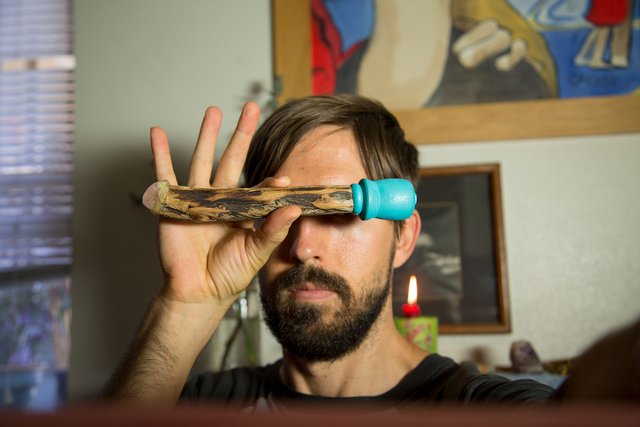 Here's what we're creating. I'm calling this maraca the “Marachimba,” because of it’s light, cricket-like sound.
Here's what we're creating. I'm calling this maraca the “Marachimba,” because of it’s light, cricket-like sound.
Introduction
I first started making maracas when I discovered that most of the maracas we find in stores are: (1) plastic; (2) mass-produced; and (3) low-quality. Try buying a maraca online, and you're likely to get one that's way too loud, or you might find one that sounds exactly like a baby rattle. The best way to get a maraca that works for you is to make it yourself.
Making maracas is a great way to find your “voice” as a musician. This activity is a good way to experiment with hand-crafting an instrument, and making it your own. I encourage you to start with the supplies and instructions you see outlined here, and then try variations as you feel inspired.
Supplies & Suggestions
Essential Supplies For Your Homemade Maraca
- Bell - The hollow blue end at the top of our maraca is called the bell.
- Filler - The rattle sound is created with beads, seeds, or bbs that shake inside the bell.
- Handle - A balanced handle allows the artist to hold the maraca with a featherlight grip.
- Bolt - Connecting the bell with the handle is plain and simple with a heavy-duty bolt.
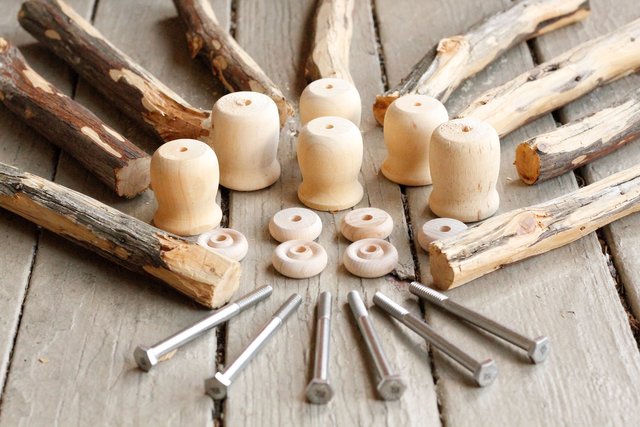 Here's what we're working with.
Here's what we're working with.
Specific Suggestions
- Candle Cups - For a light-sounding maraca, these hollow wooden blocks work well for the bell. They're sold regularly at arts and crafts stores, with the following dimensions: 1 3/8” x 1 9/16”, with a 7/8” hole.
- Bbs - I highly recommend lead shot balls for the filler. These are the tiny metal bbs that fill shotgun shells, just fyi, and they're are ideal for the small-size bells, like ours. As with anything on this list, you may want to experiment with other options to suit your own taste preferences. Seeds and beads work well in some maracas.
- Toy Wheels - To cap the filler inside the bell, we block the open end of the candle cups with little wooden wheels: 1” x 3/8”, with a 1/4” hole.
- Bolt - I recommend a hexagonal bolt: 3” x 1/4”, with a smooth shaft except for the threaded lower inch which is driven into the wood.
- Wooden Dowel - For the handle, an ordinary wooden dowel will work: 6” x 1” or narrower (most common). My personal preference is to harvest some fallen conifer sticks (cedar, juniper, pine, etc.), because: (1) they hold distinct character in the grain; and (2) they hold symbolic meaning that further enhances the maraca as a strengthening instrument.
- Sand Paper - I prefer the 150 grit sand paper, but you could go smoother if you like.
- Spray Paint - I've tried a couple of different paint options, and spray paint is best for an even color tone. The color you see here is the aquamarine tone by Rust-Oleum. Acrylic paint would work well too, if you'd rather not face the fumes. Plain wood grain is always a good option.
- Skin-Friendly Oil - I like to soften the handle with almond oil. Sesame seed oil, and others will work well too, I'm sure.
- Precious Stone - A few of my favorites are smooth aquamarine stones, quartz crystals, and decorative glass beads. These optional additions add a decorative touch to the open end, while also adding a counter-weight to enhance the balance.
- Glue - Gorilla glue is the only thing I've found that works to adhere the stone with the wood. Remember to wet both the stone and the wood before applying the glue. Occasionally, I use a hot glue gun to add an additional adhesive on the surface.
Instructions
The only equipment you'll need is: (1) an electric screwdriver with a 1/4" drill bit (or slightly smaller); and (2) a saw. Once you have the ability to drill and saw, the next step is to gather your essential supplies: bell, filler, handle, and bolt. For the bell, I rely on the wooden candle cup, less than $1 apiece, found at arts and supplies stores. For the filler, I like the lead shot balls, less than $5 for 250 ct. For the handle, I harvest cedar tree limbs for free, and alternatively you might consider buying a wooden dowel at a hardware store, less than $5. For the bolt, I buy a hex bolt at a hardware store, less than $1 apiece.
I trust you'll agree that the assembly is self-explanatory, although I do have a few tips for you. I recommend starting with the handle. Most of us have access to tree limbs, and these give you a distinct appearance and an organic handgrip. I find that cedar limbs are my personal favorites–lightweight and decorated with natural woodgrain. Aim for a handle weight and length that feels comfortable–my ideal size is 6". Use your saw to give yourself straight edges on the ends. Sand the surface and then add your favorite oil, if you're aiming for a smooth handle.
Test the sound of your bell by inserting the bolt, adding your filler, capping the end, and giving it a shake. Shake it up! How does it sound? Does it make a difference with more or less filler? Once you have the sound you like, you may want to apply the paint and let it dry before attaching the bell to the handle. When you're ready, drive your bolt through the bell and screw it an inch or so deep into the handle. I imagine it's best to keep this connection tight, in order to keep a solid seal, although I've made adjustments with mine many times. Just use your best judgment.
Symbolism
As you may know, I am passionate about the creative study of symbology. As an artist and dream interpreter, I often look for the deeper meaning in the things I see: animals, plants, sacred symbols... When I look at the maraca, I see a strengthening sword, giving us mental firmness, emotional steadiness, and physical wakefulness.
Additionally, the maraca helps us to be in a strong state of rhythm. In music, a person’s rhythm is the ability to build and sustain a strong pattern of music or sound. And in a greater sense, rhythm is the ability and willingness to align with the natural flow of life itself. Rhythms come naturally for most of us, and the heartbeat is a good example of this. The absence of a rhythm is also possible, such as an arrhythmic heartbeat, and consequences of this are easy to imagine.
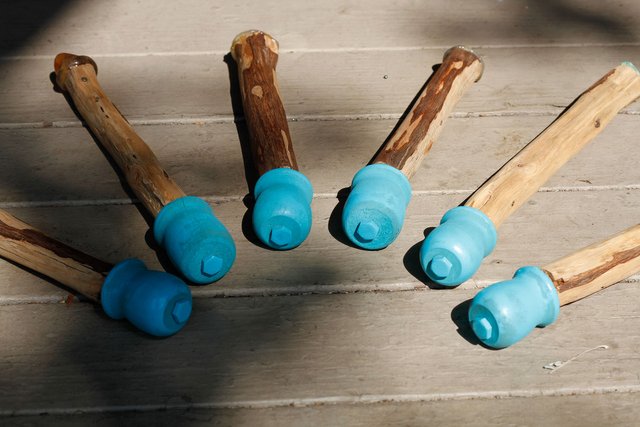 Here's what the bells look like on our finished maracas.
Here's what the bells look like on our finished maracas.
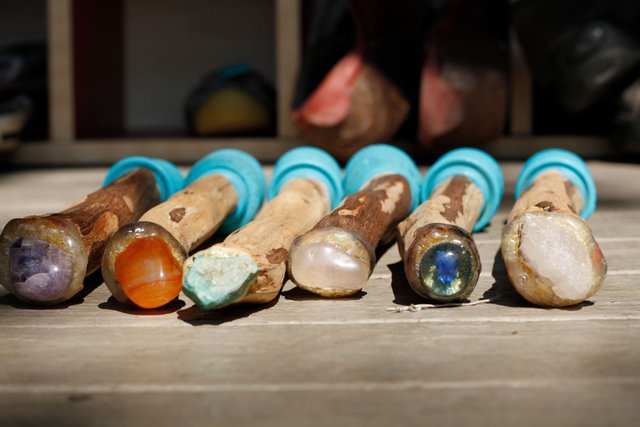 Here's what the bottoms look like, with a variety of stones: (left to right) amethyst, carnelian, chrysocolla, quartz, glass, unpolished quartz.
Here's what the bottoms look like, with a variety of stones: (left to right) amethyst, carnelian, chrysocolla, quartz, glass, unpolished quartz.
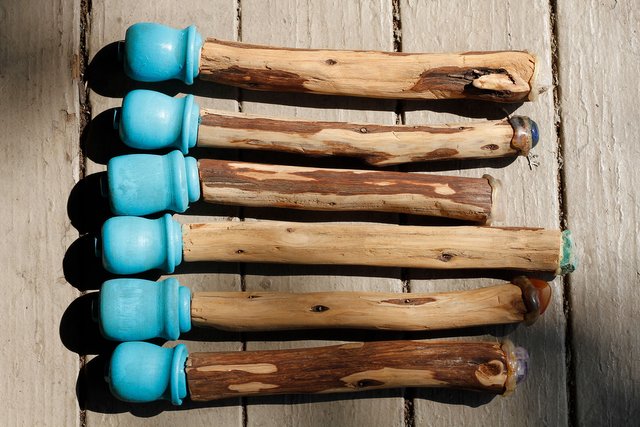
Video Demonstration
Curious what these homemade maracas sounds like? I recorded a video demo this morning, testing the new DTube video platform: “Marachimba” Homemade Maraca Demo.
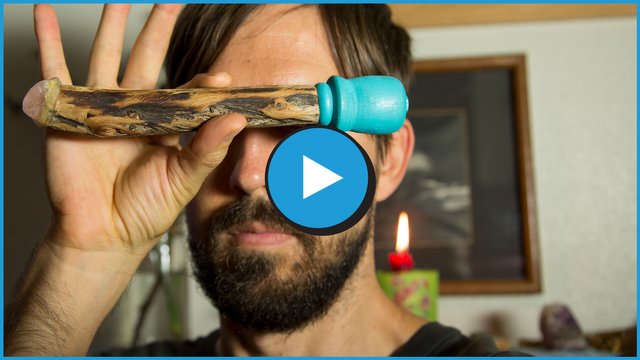 Note: This maraca demonstration is one of the first videos published on DTube. DTube is the exciting new video platform for Steemians, introduced yesterday by @heimindanger. Here's the official intro: Introducing DTube: a decentralized video platform using STEEM and IPFS.
Note: This maraca demonstration is one of the first videos published on DTube. DTube is the exciting new video platform for Steemians, introduced yesterday by @heimindanger. Here's the official intro: Introducing DTube: a decentralized video platform using STEEM and IPFS.
All content is original, written and illustrated by @cabelindsay.